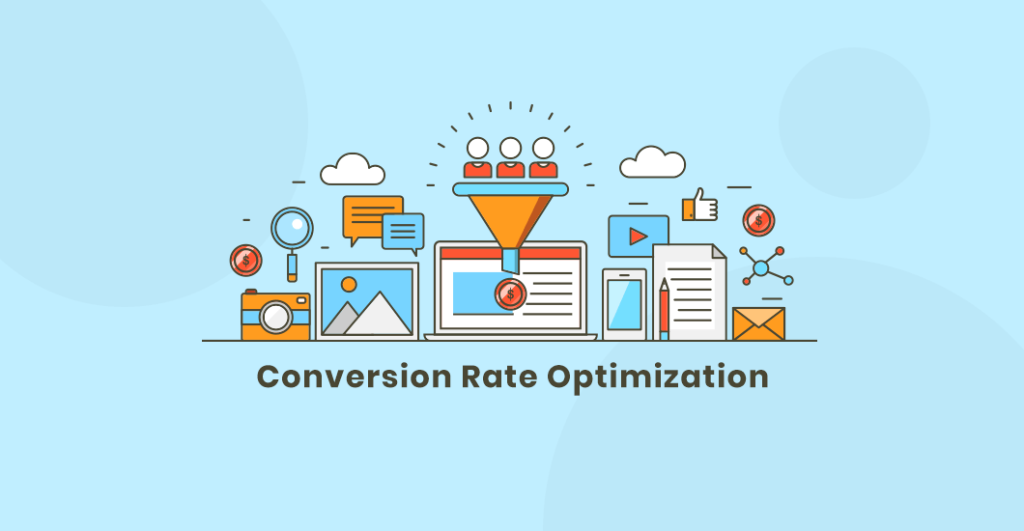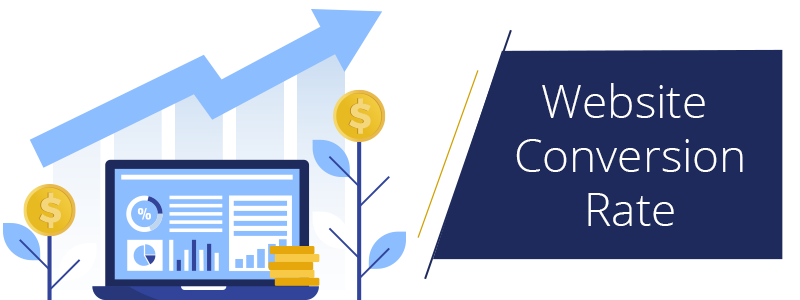But fear not! In this article, we’re going to delve into the nitty-gritty of improving your website’s conversion rate.
From crafting compelling copy to optimizing your user experience, we’ve got you covered.
Increase conversion rates meaning
Increasing conversion rates refers to improving the percentage of visitors to a website or users of a product who take a desired action. This desired action can vary depending on the goals of the business or service, but common examples include making a purchase, filling out a form, signing up for a newsletter, downloading a resource, or registering for an event.

Crafting Irresistible Headlines
First impressions matter, and when it comes to your website, the headline is often the first thing visitors see.
A catchy, attention-grabbing headline can make all the difference in enticing users to stay and explore further.
So, how can you create headlines that captivate your audience?
- Be Clear and Concise: Your headline should clearly convey the value proposition of your website.
Make it short, sweet, and to the point. Don’t be afraid to inject some personality into it, as long as it aligns with your brand.
- Create a Sense of Urgency: People love a good deal or an exclusive offer.
Use words that create a sense of urgency, like “Limited Time Offer” or “Act Now.” This encourages visitors to take immediate action.
- Use Numbers and Statistics: Numbers grab attention and lend credibility to your claims.
Incorporate specific figures in your headlines, such as “Increase Your Sales by 50% with These Proven Strategies.”
- Address Pain Points: Identify the pain points your target audience faces and address them in your headlines. By showing that you understand their challenges, you’ll pique their interest and make them more likely to stay on your website.
Remember, your headline is a gateway to the rest of your content, so make it compelling and irresistible.
Engaging Website Copy
Once you’ve grabbed visitors’ attention with your headline, it’s essential to keep them engaged with compelling website copy.
The words you choose can make or break their decision to convert.
Here’s how you can create engaging copy:
- Know Your Audience: Understand who your target audience is, their pain points, and their aspirations.
Craft your copy in a way that resonates with them, speaks their language, and addresses their needs directly. - Highlight Benefits: Focus on the benefits your product or service offers, rather than just listing its features.
Help your audience envision how their lives will improve by using what you offer. - Tell a Story: Humans love stories, so weave a narrative into your copy that captivates your audience.
Paint a vivid picture of how your product or service has made a difference in someone’s life. - Use Social Proof: People are more likely to trust your brand if they see others who have had positive experiences.
Incorporate testimonials, case studies, and reviews into your copy to build trust and credibility.
By creating engaging website copy, you’ll keep visitors hooked and increase the chances of conversion.
Enhancing User Experience for Increased Conversions
Enhancing user experience (UX) plays a vital role in increasing conversions on a website or application.
Here are some strategies you can implement to improve UX and boost conversions:
Simplify the User Interface (UI)
- Ensure that your UI is clean, intuitive, and easy to navigate.
- Use clear headings, concise labels, and logical grouping of elements.
- Remove any clutter or unnecessary elements that may confuse or distract users.
Optimize Website Speed
- Slow-loading websites can frustrate users and lead to high bounce rates.
- Optimize your website’s performance by minimizing file sizes, leveraging browser caching, and using content delivery networks (CDNs).
- A fast-loading website provides a positive user experience and encourages users to stay and explore.
Mobile Responsiveness
- With the increasing use of mobile devices, it’s crucial to have a responsive design that adapts to different screen sizes.
- Mobile-friendly websites provide a seamless experience across devices, ensuring that users can easily access and interact with your content.
Clear Call-to-Action (CTA)
- Use visually prominent and compelling CTAs that guide users towards the desired actions, such as making a purchase, subscribing to a newsletter, or signing up for a free trial.
- Ensure that CTAs are placed strategically on relevant pages and have clear, concise, and action-oriented text.
Streamline Checkout Process
- If you have an e-commerce website, make the checkout process as seamless as possible.
- Minimize the number of steps required, provide progress indicators, and offer guest checkout options.
- Simplify form fields and only ask for essential information to reduce friction and increase conversion rates.
Personalization
Tailor the user experience based on individual preferences and behaviors. Use data such as past purchases, browsing history, or demographic information to deliver personalized product recommendations, content, or offers. Personalization creates a sense of relevance and increases engagement.
Implement User Feedback Mechanisms
Provide avenues for users to provide feedback, such as surveys, ratings, and reviews.
Actively listen to user suggestions and address any concerns or issues promptly.
This not only improves the user experience but also builds trust and credibility.
A/B Testing
Experiment with different design elements, layouts, and CTAs using A/B testing. Test variations of your website or application to identify the ones that yield higher conversion rates. Continuously monitor and optimize your user experience based on data-driven insights.
Usability Testing
Conduct regular usability testing with real users to identify pain points, usability issues, and areas for improvement.
Observe how users interact with your website or application, collect feedback, and make iterative improvements based on the findings.

Optimizing Website Design and User Experience
Your website’s design and user experience play a crucial role in determining whether visitors stay or leave.
A poorly designed site can lead to high bounce rates and lost opportunities.
Here are some tips to optimize your website’s design and user experience:
Streamline Navigation
- Make it easy for visitors to find what they’re looking for by organizing your navigation menu logically.
- Use clear labels and keep the structure intuitive.
- Avoid overwhelming users with too many options.
Ensure Mobile Responsiveness
With mobile usage on the rise, it’s vital that your website is mobile-friendly.
Test your site on various devices to
Are you tired of seeing your website’s traffic go up, but your conversion rate remains stagnant? It can be frustrating when you put in all that effort to drive visitors to your site, only to see them leave without taking any action.
But fear not! In this article, we’re going to delve into the nitty-gritty of improving your website’s conversion rate.
From crafting compelling copy to optimizing your user experience, we’ve got you covered.
Read Also : List of Best Web Development Agencies in Dubai
Crafting Irresistible Headlines
First impressions matter, and when it comes to your website, the headline is often the first thing visitors see.
A catchy, attention-grabbing headline can make all the difference in enticing users to stay and explore further.
So, how can you create headlines that captivate your audience?
- Be Clear and Concise: Your headline should clearly convey the value proposition of your website.
Make it short, sweet, and to the point. Don’t be afraid to inject some personality into it, as long as it aligns with your brand.
- Create a Sense of Urgency: People love a good deal or an exclusive offer.
Use words that create a sense of urgency, like “Limited Time Offer” or “Act Now.” This encourages visitors to take immediate action.
- Use Numbers and Statistics: Numbers grab attention and lend credibility to your claims.
Incorporate specific figures in your headlines, such as “Increase Your Sales by 50% with These Proven Strategies.”
- Address Pain Points: Identify the pain points your target audience faces and address them in your headlines. By showing that you understand their challenges, you’ll pique their interest and make them more likely to stay on your website.
Remember, your headline is a gateway to the rest of your content, so make it compelling and irresistible.
Engaging Website Copy
Once you’ve grabbed visitors’ attention with your headline, it’s essential to keep them engaged with compelling website copy.
The words you choose can make or break their decision to convert.
Here’s how you can create engaging copy:
- Know Your Audience: Understand who your target audience is, their pain points, and their aspirations.
Craft your copy in a way that resonates with them, speaks their language, and addresses their needs directly. - Highlight Benefits: Focus on the benefits your product or service offers, rather than just listing its features.
Help your audience envision how their lives will improve by using what you offer. - Tell a Story: Humans love stories, so weave a narrative into your copy that captivates your audience.
Paint a vivid picture of how your product or service has made a difference in someone’s life. - Use Social Proof: People are more likely to trust your brand if they see others who have had positive experiences.
Incorporate testimonials, case studies, and reviews into your copy to build trust and credibility.
By creating engaging website copy, you’ll keep visitors hooked and increase the chances of conversion.
Read Also : Professional WordPress Development in Dubai
Enhancing User Experience for Increased Conversions
Enhancing user experience (UX) plays a vital role in increasing conversions on a website or application.
Here are some strategies you can implement to improve UX and boost conversions:
Simplify the User Interface (UI)
- Ensure that your UI is clean, intuitive, and easy to navigate.
- Use clear headings, concise labels, and logical grouping of elements.
- Remove any clutter or unnecessary elements that may confuse or distract users.
Optimize Website Speed
- Slow-loading websites can frustrate users and lead to high bounce rates.
- Optimize your website’s performance by minimizing file sizes, leveraging browser caching, and using content delivery networks (CDNs).
- A fast-loading website provides a positive user experience and encourages users to stay and explore.
Mobile Responsiveness
- With the increasing use of mobile devices, it’s crucial to have a responsive design that adapts to different screen sizes.
- Mobile-friendly websites provide a seamless experience across devices, ensuring that users can easily access and interact with your content.
Clear Call-to-Action (CTA)
- Use visually prominent and compelling CTAs that guide users towards the desired actions, such as making a purchase, subscribing to a newsletter, or signing up for a free trial.
- Ensure that CTAs are placed strategically on relevant pages and have clear, concise, and action-oriented text.
Streamline Checkout Process
- If you have an e-commerce website, make the checkout process as seamless as possible.
- Minimize the number of steps required, provide progress indicators, and offer guest checkout options.
- Simplify form fields and only ask for essential information to reduce friction and increase conversion rates.
Personalization
Tailor the user experience based on individual preferences and behaviors. Use data such as past purchases, browsing history, or demographic information to deliver personalized product recommendations, content, or offers. Personalization creates a sense of relevance and increases engagement.
Implement User Feedback Mechanisms
Provide avenues for users to provide feedback, such as surveys, ratings, and reviews.
Actively listen to user suggestions and address any concerns or issues promptly.
This not only improves the user experience but also builds trust and credibility.
A/B Testing
Experiment with different design elements, layouts, and CTAs using A/B testing. Test variations of your website or application to identify the ones that yield higher conversion rates. Continuously monitor and optimize your user experience based on data-driven insights.
Usability Testing
Conduct regular usability testing with real users to identify pain points, usability issues, and areas for improvement.
Observe how users interact with your website or application, collect feedback, and make iterative improvements based on the findings.
Read Also : Choosing the Right Partner for Custom Website Design in Dubai
Optimizing Website Design and User Experience
Your website’s design and user experience play a crucial role in determining whether visitors stay or leave.
A poorly designed site can lead to high bounce rates and lost opportunities.
Here are some tips to optimize your website’s design and user experience:
Streamline Navigation
- Make it easy for visitors to find what they’re looking for by organizing your navigation menu logically.
- Use clear labels and keep the structure intuitive.
- Avoid overwhelming users with too many options.
Ensure Mobile Responsiveness
With mobile usage on the rise, it’s vital that your website is mobile-friendly.
Test your site on various devices to
How to improve conversion rate Shopify
Improving the conversion rate on your Shopify store involves a combination of optimizing your store’s design, enhancing the user experience, and implementing effective marketing strategies. Here are some specific steps you can take:
- Enhance Website Design and Usability:
- Responsive Design: Ensure your Shopify store is mobile-friendly and looks good on all devices.
- Clean Layout: Use a clean and professional design that makes it easy for visitors to navigate and find what they are looking for.
- Clear CTAs: Use prominent and compelling calls-to-action that guide users towards making a purchase.
- Optimize Product Pages:
- High-Quality Images: Use high-resolution images with zoom-in capabilities to give customers a clear view of the products.
- Detailed Descriptions: Provide detailed and accurate product descriptions that highlight the benefits and features.
- Customer Reviews: Display customer reviews and ratings to build trust and provide social proof.
- Simplify the Checkout Process:
- Guest Checkout: Allow customers to check out as guests without requiring account creation.
- Reduce Steps: Minimize the number of steps in the checkout process to make it quick and easy.
- Multiple Payment Options: Offer a variety of payment options to accommodate different preferences.
- Improve Site Speed:
- Fast Loading Times: Optimize images, use a content delivery network (CDN), and minimize code to ensure your site loads quickly.
- Performance Monitoring: Regularly monitor and improve your site’s performance using tools like Google PageSpeed Insights.
- Personalization:
- Product Recommendations: Use AI and machine learning to recommend products based on customer behavior and preferences.
- Targeted Marketing: Personalize email campaigns and advertisements to resonate with individual customers.
- Offer Incentives:
- Discounts and Promotions: Provide limited-time discounts, bundle deals, and free shipping to encourage purchases.
- Loyalty Programs: Implement a loyalty program to reward repeat customers.
- Trust and Security:
- SSL Certificate: Ensure your site is secure with an SSL certificate.
- Trust Badges: Display trust badges and security seals to reassure customers.
- Retargeting and Abandoned Cart Recovery:
- Email Reminders: Send automated email reminders to customers who have abandoned their shopping carts.
- Retargeting Ads: Use retargeting ads to bring back visitors who didn’t complete their purchase.
- A/B Testing:
- Test Elements: Conduct A/B tests on various elements of your site, such as headlines, images, and CTAs, to determine what works best.
- Iterate and Improve: Continuously test and refine your strategies based on data and user feedback.
- Customer Support:
- Live Chat: Implement live chat support to assist customers in real-time.
- FAQ Section: Provide a comprehensive FAQ section to answer common questions.
- Social Proof and User-Generated Content:
- Customer Photos and Videos: Encourage customers to share photos and videos of your products in use.
- Social Media Integration: Display social media feeds and testimonials on your site.
By focusing on these areas, you can create a more compelling and user-friendly shopping experience on your Shopify store, leading to higher conversion rates.
conclusion
In conclusion, boosting your website’s conversion rate requires a multifaceted approach. By crafting compelling headlines, engaging copy, and enhancing the user experience, you can significantly improve visitor engagement and conversions.
Key strategies include optimizing website speed, ensuring mobile responsiveness, simplifying the user interface, and streamlining the checkout process. Additionally, personalization, user feedback mechanisms, A/B testing, and usability testing are essential for continuous improvement.
Implementing these techniques will help transform your website into a powerful conversion tool, driving better results and achieving your business goals.

